Bandelier National Monument
Wednesday, May 16, 2007I had two longstanding misconceptions that our visit to Bandelier National Monument cleared up:
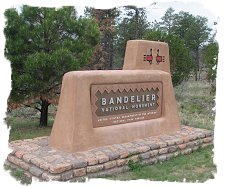
1) Native American ruins are rather rare and unique to just a few spots in the general area of the 4 corners.
2) The Anasazi one day just up and disappeared for completely unknown reasons.
Both impressions are wrong – there are thousands of native American ruins in this region of the country, and the Ancestral Pueblo migrated away from their canyon based villages into the larger Pueblo settlements, (over 20 of which are still inhabited today), such as the Taos and San Ildefonso Pueblos.
But what about the Anasazi? Anasazi is a Navajo term borrowed by Spanish explorers to describe the people who used to inhabit these ancient villages. The usage is considered disrespectful by contemporary Pueblo Native Americans, who are from other tribes. Hence, Ancestral Pueblo is the term in current vogue.
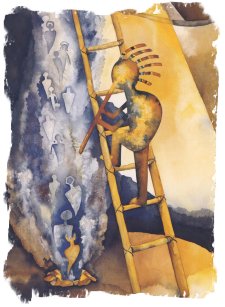 Bandelier National Monument is named after the self taught Swedish anthropologist Adolph Bandelier (who did many of the early excavations and studies of the sites within the current park). In 1880, he began the study of the ruins in Frijoles Canyon, and developed a methodology that allowed him to tie the ruins to the existing Pueblos, using similarities in construction, traditions and trade items. His work laid the foundations for many of the techniques used in modern day archeology in the American Southwest.
Bandelier National Monument is named after the self taught Swedish anthropologist Adolph Bandelier (who did many of the early excavations and studies of the sites within the current park). In 1880, he began the study of the ruins in Frijoles Canyon, and developed a methodology that allowed him to tie the ruins to the existing Pueblos, using similarities in construction, traditions and trade items. His work laid the foundations for many of the techniques used in modern day archeology in the American Southwest.The park is about an hour from Santa Fe, located in the Jemez Mtn range not far from Los Alamos. Our National Parks of the Southwest book warned us that Bandelier had parking issues, and it was right – although we arrived mid-morning and mid-week, the parking lot was almost full. Not much later in the day there was a line of cars waiting for a space! This was surprising for what we thought was a lightly visited park, but we were wrong.
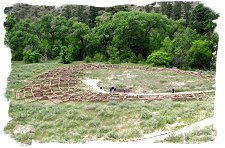 There were several distinct styles of ruins in the park – the first we visited was on the floor of the canyon. These ruins were the foundations and part of the walls of a rather extensive Pueblo style village called Tyuonyi. This was a round village of small apartments (all entered from the top) that housed several hundred people.
There were several distinct styles of ruins in the park – the first we visited was on the floor of the canyon. These ruins were the foundations and part of the walls of a rather extensive Pueblo style village called Tyuonyi. This was a round village of small apartments (all entered from the top) that housed several hundred people.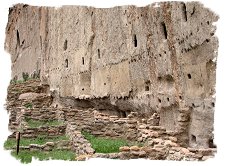 Further up the path was the ‘Long House’, which is the foundation of a series of buildings at the foot of the canyon walls, using the rock face as the back wall of the structures. These structures were several stories high – you could tell how many stories by the line of round holes in the canyon walls. These holes are where the logs supporting the roofs, called vigas, were placed. Intermixed with these ruins are hollowed out caves in the canyon wall, where soot marks indicate previous habitation.
Further up the path was the ‘Long House’, which is the foundation of a series of buildings at the foot of the canyon walls, using the rock face as the back wall of the structures. These structures were several stories high – you could tell how many stories by the line of round holes in the canyon walls. These holes are where the logs supporting the roofs, called vigas, were placed. Intermixed with these ruins are hollowed out caves in the canyon wall, where soot marks indicate previous habitation.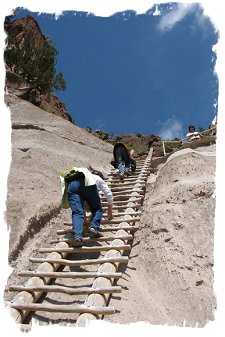 The final ruin we viewed was the Alcove House. Located up canyon from Tyuonyi, this ruin is more in the cliff dwelling style of Mesa Verde. We’re pretty used to the coddling that the Park Service does for visitors in the East, where dire warnings are posted for any walk more than 10 feet long. So the approach to Alcove House rather surprised us – it was the equivalent of a 10-12 story climb up a set of 3 wooden ladders and narrow stone pathways. It wasn’t dangerous (as long as you didn’t let go!), but was still a bit of a thrill. Vance enjoyed the climb up and back immensely, and wanted to do the whole thing over again. Laboring a little bit in the thin air (6000+ feet elevation) we declined the repeat adventure, and settled for our one time up and back!
The final ruin we viewed was the Alcove House. Located up canyon from Tyuonyi, this ruin is more in the cliff dwelling style of Mesa Verde. We’re pretty used to the coddling that the Park Service does for visitors in the East, where dire warnings are posted for any walk more than 10 feet long. So the approach to Alcove House rather surprised us – it was the equivalent of a 10-12 story climb up a set of 3 wooden ladders and narrow stone pathways. It wasn’t dangerous (as long as you didn’t let go!), but was still a bit of a thrill. Vance enjoyed the climb up and back immensely, and wanted to do the whole thing over again. Laboring a little bit in the thin air (6000+ feet elevation) we declined the repeat adventure, and settled for our one time up and back!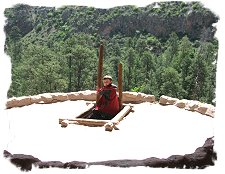
In the alcove, sitting 140 feet above the canyon bottom, is a reconstructed kiva. A kiva is a round room that appears in almost every ruin in this area, believed to be used for family centered ceremonial functions, based on current Pueblo traditions. Almost all kivas contain the same elements, and similar construction styles have helped tie Ancestral Pueblo sites to their modern day decendents. With the energy to spare, Vance found great delight in climbing in and out of the kiva multiple times.
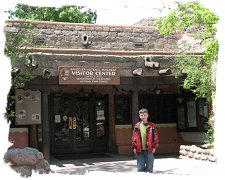 The Visitor Center itself is another one of the CCC wonders, constructed in an adobe style. Many of the outbuildings were originally used for a lodge, but are now used by the Park Service. For a period of time during WWII the lodge buildings were used to house scientists working on the development of the atomic bomb at nearby Los Alamos. The Visitor Center had a display on the construction techniques used by the CCC, and featured some of their craftwork - furniture and tinwork light fixtures.
The Visitor Center itself is another one of the CCC wonders, constructed in an adobe style. Many of the outbuildings were originally used for a lodge, but are now used by the Park Service. For a period of time during WWII the lodge buildings were used to house scientists working on the development of the atomic bomb at nearby Los Alamos. The Visitor Center had a display on the construction techniques used by the CCC, and featured some of their craftwork - furniture and tinwork light fixtures.Bandelier was a good introduction to the Ancestral Pueblo culture, and we are looking forward to seeing other ruins, such as the cliff dwellings at Mesa Verde in Colorado. Vance completed his Jr. Ranger program by mid-afternoon, and learned a few things along the way – for example, he found out that Ponderosa Pine tree bark has a vanilla scent! We also learned that many of these ruins are located in canyon bottoms, because that is where the springs, seeps and creeks are found in this area of low rainfall.

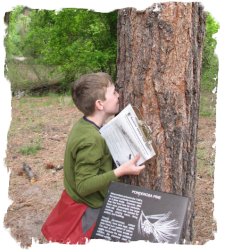 Vance: Bandelier NM is amazing! 100s of years ago, the Ancestral Pueblo people lived there. On the trail there are ladders that you can climb to see inside the cliff dwellings. One kind of tree in the monument is called the Ponderosa Pine. The ponderosa smells like vanilla.
Vance: Bandelier NM is amazing! 100s of years ago, the Ancestral Pueblo people lived there. On the trail there are ladders that you can climb to see inside the cliff dwellings. One kind of tree in the monument is called the Ponderosa Pine. The ponderosa smells like vanilla.The Ancestral Pueblo people carved and painted on the stone walls. A petroglyph is a symbol carved on a wall and a pictograph is a painting on the wall.
A KIVA WAS THEIR CEREMONIAL UNDERGROUND ROOM!
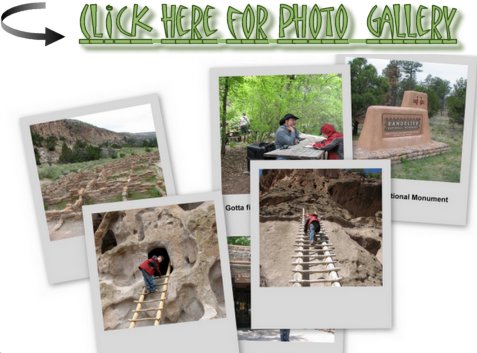
| Prev - Bradbury Science Museum | | Home | Index | | The High Road to Taos - Next |







<< Home